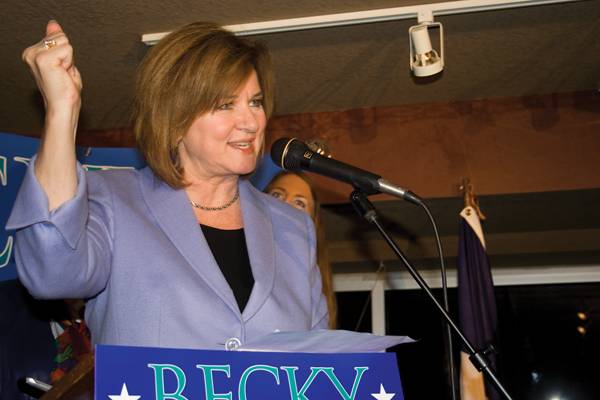Women face challenges in Iowa elections

Becky Greenwald, runner up for U.S. Representative, district 4, speaks to supporters in Legends Bar and Grill on Tue., Nov. 4, 2008 shortly after hearing the results of the election. Greenwald lost to Tom Latham. Photo: Laurel Scott/Iowa State Daily
December 1, 2008
Six states have never elected a woman to the U.S. House of Representatives. Four states have not elected a woman to Congress. And only two states — Iowa and Mississippi — have neither elected a female governor, nor to the U.S. Senate or House of Representatives.
Mary Kramer, former U.S. ambassador and president of the Iowa Senate, said electing a woman in Iowa is “not so much about gender as it is about opportunity.”
Both Becky Greenwald and Mariannette Miller-Meeks ran in the 2008 election for the U.S. House of Representatives’ fourth and second districts, respectively. Both lost their elections to incumbent males.
Neither said she perceived any discrimination during her campaign and they said they do not attribute their losses to sexism.
“I was not running as a woman candidate, I was a candidate who happened to be a woman,” Greenwald said.
Five women met in November, following Election Day, to discuss the reasons behind Iowa’s ranking. Iowapolitics.com, a nonpartisan news Web site, hosted the program.
The panel included Kramer, Miller-Meeks, Dianne Bystrom, director of the Carrie Chapman Catt Center for Women and Politics, Greenwald, and Jo Ann Zimmerman, former lieutenant governor and president of the Iowa Senate.
Making up more than 50 percent of the population, nationally and in Iowa, women are often left out of the political process as seen by their small numbers in local, state and national governments. Miller-Meeks said women have traits that are useful to the political process.
“We’re consensus builders. We’re collaborators. We listen. Those talents, and that doesn’t mean men don’t have them, but I think that you find that more in women,” Miller-Meeks said.
Yet the fact remains that Iowa has yet to elect a woman. Some blame this on poor timing — a “historical fluke,” as Tracy Osborn, assistant professor of political science at the University of Iowa, said in an interview with Iowa Public Radio’s “The Exchange.”
This “fluke” is the culmination of a number of factors, including Iowa’s small number of seats in the U.S. House of Representatives and, as Osborn said, that incumbents are highly favored in elections here.
Bystrom says several demographic trends prevalent in Iowa have also caused men to win elections and discouraged women from running for office. Her research highlights trends existing in states that tend to elect more women.
“They tend to be growing states — growing in population. They tend to be more ideologically liberal, and we’re really more moderate. They tend to have a growing younger population, and ours is older. They tend to be more urban than rural. So we have a lot of factors going against us that we really can’t do anything about,” Bystrom said.
In addition, she said, basic differences between the sexes cause more men to think they are capable of running for office than women, even if women are equally qualified.
“Men wake up in the morning, look in the mirror and say ‘I can be governor,’ and women need to be asked,” Bystrom said.
Zimmerman reiterated Bystrom’s sentiment and said women wait to be asked to run for office, and recruiting women early is central to having more women in politics in Iowa.
Kramer, who said she began considering to run for office only after being recruited by fellow women, said seeking the opportunity is the real issue.
“The most opportune time is when there is no incumbent and when you are in a position when you have raised enough money to get your message out there almost immediately,” Kramer said.
Zimmerman said local party leaders “do not go out and recruit women” because they are often men who are used to dealing with other men.
“It’s just fear of change,” Zimmerman said. “If things are comfortable, why change it? If we’ve had men always at this place, why should we change it? And so sometimes you come off thinking, ‘well, maybe I have to be better than the man I’m running against to get that position.’”
Thirty-four women currently hold seats in the Iowa Legislature, the highest number in Iowa’s history, which has remained unchanged over the past three elections. Iowa’s percentage of women in state legislature ranks 23rd in the nation.
The highest percentage is currently found in Vermont, with 38.3 percent, while South Carolina ranks last, with a mere 8.8 percent of its state legislature made up of women, according to Rutgers’ Center for American Women and Politics.
“The fact of the matter is that we need to get more women to run for office in Iowa.” Bystrom said. “There have been only 17 women running for congress in 13 races, only two of them have run in open seat races.”
In order to encourage more women to become active in politics, Bystrom and the Carrie Chapman Catt Center are hosting their second Ready to Run: Campaign Training for Women on April 3, 2009.
In cooperation with the League of Women Voters of Ames, the program is a day-long workshop that will teach participants how to confront stereotypes and put their campaigns together, with special focus on how to raise money, Bystrom said.
“We’re trying to change the culture and the climate and get Iowa off that list of being only one of four states,” Bystrom said.






